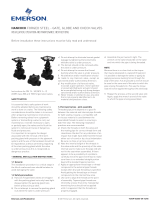
Apollo 2 Piece Threaded Steel and Steel Alloy Ball Valves
Installation, Operation, & Maintenance Guide
debris that could prevent positive valve shutoff. Two wrenches must
be used when making up pipe joints to these valves. Apply one
wrench on the valve end closest to the pipe joint being tightened and
the other wrench to the pipe to prevent transmitting torque through the
valve body joint. Typical pipe make-up is 1-1/2 turns after installing
the pipe hand-tight.
Operation
Ball valves are intended to be on-off devices operating through 90
o
of
stem rotation. The valve handle is marked showing proper rotation
direction for “ON” and “OFF” positions. Rotation is clockwise for
“OFF” (closed) and counterclockwise for “ON” (open).
The most common service failures not related to the installation and
start-up processes are:
Exceeding the operating temperature or pressure limits of the valve
due to a process upset condition.
A chemical attack on valve components due to either
misapplication or changes in the service.
Violating temperature and pressure limits can result in immediate
valve failure where chemical attack or corrosion generally occurs
gradually.
Maintenance
Valve Adjustments
Normal stem packing wear can be compensated for by tightening the
packing gland screw. (Wrench part number H371400 is available to
ease this operation.) Tighten the packing gland screw clockwise in
1/8 turn increments until observed leakage stops. Do not exceed the
values shown in Table 1. If all of the adjustments to the packing gland
screw have been made, remove the handle nut, handle and packing
gland screw and add one or two replacements bearings on top of the
old packing. Reinstall the handle and handle nut.
Caution: Do not disassemble valve while under pressure nor with
entrapped hazardous fluids therein.
Disassembly
1) Operate the valve fully opened to fully closed to assure there are
no trapped fluids or pressure in the body cavity. Leave the valve
in the closed position.
2) Remove the handle nut, handle and packing nut. Set aside for
reuse.
3) Install pipe plugs in the body and retainer ports of NPT valves to
prevent collapsing those areas.
4) Remove the retainer from the body. It may be necessary to heat
the body joint above 450°F to breakdown the sealant used to
secure the valve halves.
5) Remove the ball from the body cavity. Inspect the ball. If it is
scarred, it is recommended that the whole valve be replaced, but
replacement balls are available. Clean and set aside good balls
for reuse.
6) Push the stem from the outside into the body cavity. Inspect the
stem. If it is scarred or has damaged threads, replacements are
available. Clean and set aside good stems for reuse.
7) Remove all seals and seats from the body and retainer then
discard. Inspect the body and retainer for damage. If damaged,
scrap the valve as replacements of these components are not
offered.
Re-Assembly
1) Install stem bearing on to stem.
2) Fit stem into body from the retainer end and position the stem
with the handle flats perpendicular to the flow axis.
3) Install stem packing over stem and fit into body recess.
4) Install packing gland screw into the threaded stem area.
5) Tighten the gland screw to manufacturing torque
specifications, shown in Table 1.
6) Install the handle and handle retaining hardware.





